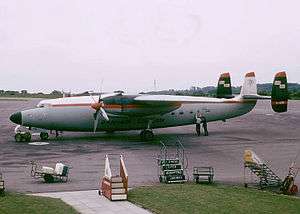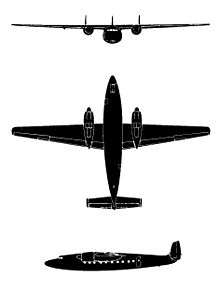Airspeed Ambassador
| AS.57 Ambassador | |
|---|---|
 | |
| Dan Air Ambassador at Bristol Airport in 1965 | |
| Role | Airliner |
| Manufacturer | Airspeed Ltd |
| First flight | 10 July 1947 |
| Introduction | 1951 |
| Primary user | British European Airways |
| Produced | 1947–1953 |
| Number built | 23 |
|
| |
The Airspeed AS.57 Ambassador was a British twin piston-engined airliner that first flew on 10 July 1947 and served in small numbers through the 1950s and 1960s.
Design and development
The Ambassador had its origin in 1943 as a requirement identified by the Brabazon Committee for a twin-engined short-to-medium-haul replacement for the Douglas DC-3. Airspeed Ltd. was asked to prepare an unpressurised design in the 14.5-ton gross weight class, using two Bristol Hercules radial engines. In 1943, the company duly set up a dispersed design office in Fairmile Manor at Cobham in Surrey.
By the time the British Ministry of Aircraft Production ordered two prototypes from Airspeed, immediately after the end of the Second World War, the design had grown substantially. The Ambassador would be pressurised, have more powerful Bristol Centaurus radials and have a maximum gross weight of almost 24 tons.
The revised design offered seating for 47 passengers and, having a tricycle undercarriage, looked more modern than the DC-3s, Curtiss Commandos, Avro Lancastrians and Vickers Vikings that were common on Europe's shorter airline routes. With three low tailfins and a long pointed nose, it shared something of the character of the larger transcontinental Lockheed Constellation.
Great efforts were made to reduce drag, to improve performance and cruising efficiency. The engine nacelles were first designed with inwardly opening louvres for exhaust gases and cooling air rather than the usual outwardly opening "gills". However, these proved inadequate to cool the engine, so the gills were reinstated.[1]
Operational history
Three prototypes were built, the first registered G-AGUA was first flown by George B.S. Errington from Christchurch on 10 July 1947.[2] British European Airways (BEA) placed a £3 million order for 20 aircraft in September 1948, and operated them between 1952 and 1958, calling them their "Elizabethan Class" in honour of the newly crowned Queen.[2] The flagship of the fleet was G-ALZN, appropriately named "RMA Elizabethan". The first "Elizabethan" scheduled flight was from Heathrow to Paris Le Bourget on 13 March 1952 and the type later also served the key UK routes. By December 1955 the "Elizabethan Class" had reached 2,230 flying hours annually, per aircraft, the highest in BEA's fleet. However, the last Elizabethan scheduled service for BEA was operated in August 1958, and the type was replaced by the Vickers Viscount.

After disposal by BEA, the type helped to establish the scheduled and charter flight operations of Dan-Air, an important airline in the development of package holidays. The type was also used in the UK by Autair and BKS Air Transport. Second-hand Ambassadors were flown for short periods by Butler Air Transport (Australia), Globe Air (Switzerland) and Norrønafly (Norway).[3]
The second Ambassador 2 G-AKRD was used by the Bristol Aeroplane Company from 1953 for the flight testing of the Bristol Proteus 705 turbine engine. From March 1958 G-AKRD was used by Rolls Royce for proving the Tyne turboprop. The first Ambassador 2 G-ALFR was used from 1955 in the development trials of the Napier Eland turbine engine.
The popularity of this aircraft, with its pressurised cabin and good soundproofing, was soon eclipsed by the arrival of turboprop-powered aircraft such as the Vickers Viscount and, some years later, the Lockheed Electra, which featured more reliable engines and faster speeds. The coming of turboprops and the dawning of the jet age caused the Ambassador to fall out of favour, along with negative publicity arising from two fatal crashes.
Variants

- AS.57 Ambassador 1
- Prototype aircraft with Bristol Centaurus engines, two built.
- AS.57 Ambassador 2
- Production aircraft, 21 built.
Projects
- AS.59 Ambassador II
- Project for either a twin-engined variant with Bristol Proteus or Bristol Theseus engines or a four-engined variant with Napier Naiads or Rolls-Royce Darts.[4] From the first prototypes, the Ambassador's wing had been stressed for four engine points, but no four-engined variant flew.[5]
- AS.60 Ayrshire C.1
- Proposed variant to meet Air Ministry Specification C.13/45 for a medium-range military transport.[4] Ten were ordered in October 1946 but were not built, after a review of the design's projected performance produced figures lower than the Air Ministry's requirements.[6]
- AS.64
- Proposed military transport variant for the Royal Air Force to meet Air Ministry Specification C.26/43, not built.[4]
- AS.66
- Proposed civil freighter variant.[4]
- AS.67
- Proposed civil freighter variant.[4]
Accidents and incidents
- 8 April 1955: G-AMAB, Sir Francis Bacon of British European Airways was damaged beyond repair in a forced landing south-west of Düsseldorf, Germany.[7][8]
- 6 February 1958: in what became known as the Munich air disaster, an Ambassador crashed on takeoff after a refuelling stop at Munich while operating a charter flight from Belgrade, Yugoslavia, to Manchester, England. This crash received tremendous public attention in the UK as it involved team members and staff of Manchester United Football Club, together with representatives of the national press. 23 of the 44 people on the plane died as a result of their injuries in the crash, including eight Manchester United players.[9] The eventual enquiry decision centred on runway slush affecting the take-off speed adversely.
- 16 April 1966: G-ALZZ of Dan-Air was damaged beyond repair when landing at Beauvais, France.[7]
- 3 July 1968: a BKS Air Transport Ambassador crashed at London Heathrow Airport. All but two of its crew as well as several horses which were being transported and their grooms, were killed. A parked Trident airliner was damaged beyond repair and another Trident had its tail torn off before the airliner hit terminal buildings and came to rest. The accident was found to have been caused by the failure of a flap actuating rod in the Ambassador's port (left) wing. Coincidentally, the Trident which suffered the damaged tail (G-ARPI) was subsequently repaired and later involved in an (unconnected) fatal accident in June 1972.[10]
- 30 September 1968: G-AMAG of Dan-air was damaged beyond repair in a wheels-up landing at Manston, United Kingdom.[7][11]
Operators
Civil operators
- Butler Air Transport - operated three different aircraft
- Norrønafly - proposed to operate two aircraft but they never entered service.
- South Seas Airways - bought one aircraft but failed to gain an operators licence and it was never delivered to New Zealand.
- Globe Air - operated three different aircraft

- Autair International Airways - operated three different aircraft
- BKS Air Transport - operated three different aircraft
- British European Airways - operated 20 different aircraft
- Dan Air - operated seven different aircraft
- Decca Navigator Company - one aircraft
- Napier
- Rolls-Royce
- Shell Aviation Limited - two aircraft
Military operators
- Royal Jordanian Air Force operated three former British European Airways aircraft, first one delivered in 1959.
- Moroccan Royal Flight
Aircraft on display
One Elizabethan, Christopher Marlowe (G-ALZO, c/n 5226), survives and is under long term major restoration by the Duxford Aviation Society at the Imperial War Museum, Duxford near Cambridge.
Specifications

Data from Jackson 1959, p. 30
General characteristics
- Crew: three
- Capacity: Up to 60 passengers
- Length: 82 ft 0 in (24.99 m)
- Wingspan: 115 ft 0 in (35.05 m)
- Height: 18 ft 10 in (5.74 m)
- Wing area: 1,200 ft² (111.48 m²)
- Empty weight: 35,377 lb (16,047 kg)
- Loaded weight: 52,500 lb (23,814 kg)
- Powerplant: 2 × Bristol Centaurus 661 two-row sleeve-valve radial piston engine, 2,625 hp (1,958 kw) each
Performance
- Maximum speed: (75% power, 11,650 (5,284 kg)) 312 mph
- Cruise speed: 260 mph (418 km/h)
- Range: 550 miles (885km)
- Rate of climb: 1,250 ft/min (6.35 m/s)
See also
- Aircraft of comparable role, configuration and era
- Related lists
References
- Notes
- ↑ Boot, pp.25-26.
- 1 2 Singfield 2000, p. 12.
- ↑ Jackson 1973, pp. 395–396.
- 1 2 3 4 5 "Airspeed Type Designations." Flight International, 23 February 1951, p. 228.
- ↑ Boot, p.25
- ↑ Boot, p.24
- 1 2 3 Eastwood and Roach 1991, p. 7.
- ↑ "Accident description: Airspeed AS.57 Ambassador 2, 8 April 1955." Aviation-safety.net. Retrieved: 13 November 2010.
- ↑ "Accident description: Airspeed AS.57 Ambassador 2, 6 February 1958." Aviation-safety.net. Retrieved: 6 May 2012.
- ↑ "Accident description: Airspeed AS.57 Ambassador 2, 3 July 1968." Aviation-safety.net. Retrieved: 6 May 2012.
- ↑ "Accident description: Airspeed AS.57 Ambassador 2, 30 September 1968."Aviation-safety.net. Retrieved: 13 November 2010.
- Bibliography
- Boot, Roy. From Spitfire to Eurofighter: 45 years of Combat Aircraft Design. Shrewsbury, UK: AirLife Publishing, 1990. ISBN 1-85310-093-5.
- Eastwood, Tony and John Roach. Piston Engine Airliner Production List. West Drayton, UK: The Aviation Hobby Shop, 1991. ISBN 0-907178-37-5.
- Jackson, A.J. British Civil Aircraft since 1919 Volume 1. London: Putnam, 1974. ISBN 0-370-10006-9.
- Jackson, A.J. British Civil Aircraft since 1919 Volume 1. London: Putnam, 1959.
- James, Derek. "Database: Airspeed Ambassador". Aeroplane Monthly. Volume 31, Issue 04, April 2003
- Singfield, Tom. Classic Airliners. Leicester, UK: Midland Publishing, 2000. ISBN 1-85780-098-2.
External links
| Wikimedia Commons has media related to Airspeed AS.57 Ambassador. |
- List of magazine articles and publications on the Ambassador
- Image of an Ambassador
- "Airspeed (AS.57) Ambassador" a 1947 Flight article
| ||||||||||||||||||||||||||||||||||||